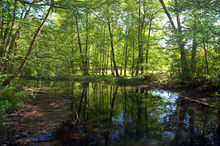Biesenthal fortified mill
Wehrmühle is a place in the city of Biesenthal about 1.5 kilometers north of the city center. It takes its name from the Biesenthal military mill, a mill on the Finow that has existed since the Middle Ages . The mill building burned down in 2002, an administrative building that was converted into a villa in 1907 has been preserved.
history
It was first mentioned in a document as Werremole or Werremol as early as 1375. At the time of the lords of the castle on the Schlossberg in Biesenthal, the fortified mill served as a protective shield for the castle complex . The name refers to a Landwehr that drew danger, so the water of the Finow was dammed until the area around the castle was flooded. Then only the castle on the Schlossberg remained in the dry. In the Ascanian era, when the fortified mill was built, there were no notable military conflicts around Biesenthal. Finow Castle near Hohenfinow was the most exposed position on the border with the Slavs and withstood all siege attempts, which is why there were hardly any disputes in the hinterland.
Modern times
The old administration building was preserved, which was converted in 1907 by the Jewish entrepreneur Mühsam into a villa with the stucco facade that still exists today. The original building as well as the sack warehouse that still exists today was built around 1870. During the Third Reich, the fortified mill was expropriated and transferred to a Müller family. During the Second World War, the building was covered with a large camouflage net and the Wehrmacht used the area at times to repair vehicles there.
During the GDR era, the building housed several apartments and a stable for dairy cows was built in the mill yard; later Haflinger horses were bred. In 1974 the mill was stopped, the mill technology including the turbine remained in place until 2002. The mill consisted of a flour mill with 2 grinding stages, 2 roller mills, plansifter, cleaning, mixer, elevators and a Francis turbine . In 1989 the Francis turbine was renovated again.
After the fall of the Wall, the entire property was bought by a Duisburg entrepreneur in 1998. After abandoning the property, the abandoned mill burned down on August 23, 2002.
Rebuilding
In 2003 the building with the ruins of the mill was sold and rebuilt. The mill was destroyed, the roof of the administration building had burned down. The remains of the mill were torn down. The front part of the building and the cellar were preserved, the rear part was demolished and replaced by a new building.
After the completion of the new building in March 2006, the "ART Biesenthal" art exhibition took place in the Wehrmühle every year until 2010. The house has been used several times as a backdrop for films, advertising photos and music videos. The house is privately owned, is partly used by the owner's company and rented out as an event location. The entire property is open to the public on certain days.
In 2010/11 a base ramp was built to stabilize the landscape water balance and to create the ecological continuity of the Finow river in place of the old turbine system. The water management measure was carried out by the “Finowfließ” water and soil association. The turbine and some other parts have been preserved as a monument.
Web links
Individual evidence
- ↑ Brandenburgisches Namenbuch: Die Ortnames des Barnim , H. Böhlaus Nachf. , Weimar 1984, p. 261.
Coordinates: 52 ° 46 ′ 26.8 ″ N , 13 ° 37 ′ 40.9 ″ E


